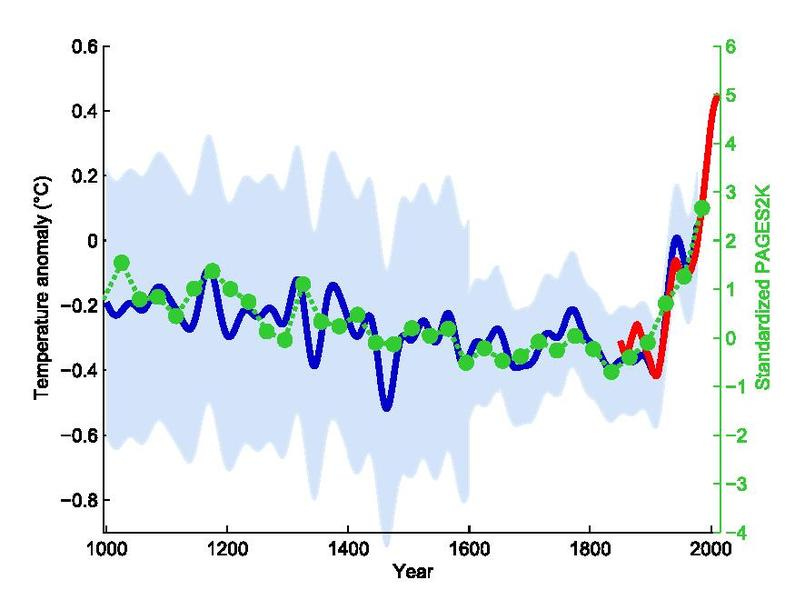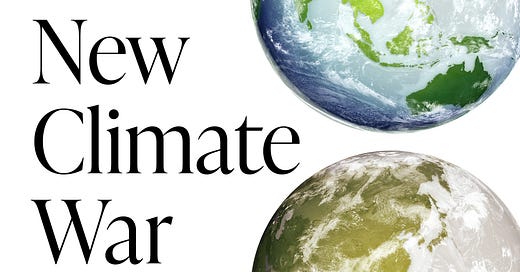🏙 Cities in Mind is your go-to destination to learn about cities, technology, innovation and the people behind them. All that through an Asian perspective.
About me: 👋🏻 I am Fabien, an urban planner based in Singapore since 2015. I write this regular newsletter and host a podcast series, that you can find on Apple Podcasts or Spotify.
If you’re seeing this newsletter for the first time, feel free to sign up so you don’t miss the next issues and podcast episodes. You can also share Cities in Mind around you.
This week, I review the latest book of Michael E. Mann, a prominent American climatologist and geophysicist, director of the Earth System Science Center at Penn State University.
I am not a climate change expert but I decided to spend 2021 educating myself on the topic. I am still trying to get my head around this complex, multi-layered and defining issue of our time, so please bear with me as I articulate my ideas 🙏🏻
Who’s Michael E. Mann?
For those who don’t him, Mann has for decades pioneered techniques to find patterns in past climate change and to isolate climate signals from noisy data.
In 1999, his team used advanced statistical techniques to produce a reconstruction of temperature changes over the past 1,000 years, which was dubbed the "hockey stick graph" because of its shape.
This graph basically says that we’re in trouble. After a long period of relatively minor temperature variations (the "shaft" of the hockey stick), it shows a sharp mercury upswing during the last century or so ("the blade").
In 2001, the UN's Intergovernmental Panel on Climate Change (IPCC) prominently featured the hockey stick in its Third Assessment Report. The IPCC acknowledged that Mann’s work, along with many other scientific lead authors, contributed to the award of the 2007 Nobel Peace Prize to the IPCC and Al Gore.

Among many recent climate change-related books, including Bill Gates’ How to Avoid a Climate Disaster, I decided to start with Mann’s because of his lucid approach of climate politics and his comprehensive command of climate science.
I wasn’t disappointed.
The New Climate War and the 3 Ds
Mann has decades of experience on the front lines of the battle to communicate the science of climate change. Climate deniers have thrown all their might at disproving his famous hockey stick graph and Mann later became an expert in disinformation campaigns of the fossil fuel industry.
In The New Climate War, Mann starts by explaining that climate change denial is going extinct. Due to the impacts of climate change no longer being subtle, the most hard-core deniers are increasingly ignored and unable to garner high media coverage (even Fox News has its internal rifts on the topic).
Deniers are being replaced by other breeds, namely: “deflectors”, “delayers” and “doomers” (the 3 Ds). Fossil fuel companies, right-wing plutocrats and oil-funded governments are teaming up to design new strategies to keep profiting from our dependence on fossil fuels. Here’s how.
↩️ Deflection
Inspired by communication campaigns led by the gun lobby, the tobacco industry or beverage companies, the “inactivists”, as Mann called this mixed bag of corporations, lobbies and governments promoting fossil fuels, aim at shifting responsibility from companies to individuals. By fixating on the importance of voluntary actions (going vegan, avoiding flying..), deflectors take the pressure off their shoulders and push back governmental policies to hold them accountable.
Not that personal actions are not worth taking but emphasising too much on their importance could have a pernicious indirect effect (what we call “nudging out“), offering the promise of a potential quick and easy fix, thereby undermining support for policies of greater impact.
Mann goes on and gives many examples of deflection campaigns, from online bots and trolls to social media manipulation, aimed at dividing the climate advocacy community and exploiting preexisting wedges between climate advocates more focused on individual action and those emphasising strong policy action.
By forcing purity tests on climate scholars and advocates (“before I listen to you, what’s your carbon footprint?”), inactivists manages to deflect the attention on other issues and problems, which leads to the second D.
⏰ Delay
Deflection campaigns have helped inactivists gain extra time and Mann illustrates how they have been attacking solutions such as carbon pricing and renewable energies.
According to him, carbon pricing is one of the most powerful tools we have to decarbonise our economies. Constant hesitations to include it or not in green economy plans (Mann takes the example of the US’ Green New Deal where carbon pricing has been removed) end up delaying any concrete steps towards decarbonisation.
Green New Deal vs Carbon Tax (and Dividend Plans): a clash of ideologies that blurs the perspective of a fundamental transition in our global economy.
Mann also shows how lobbies have manipulated myths about the supposed environmental threats of wind turbines and solar panels or instrumentalized arguments such as “lost jobs” or “bans on fossil-fuel entrenching poverty in third world countries”.
Mann is indeed convinced that “the safest and healthiest path to economic development in the third world is access to clean, decentralised, renewable energy, and the greatest opportunity for job growth in the energy industry comes with renewables, not fossil fuels”.
🤯 Doomism
Finally, Mann introduces his last D, “doomism”, a narrative made of exaggerated claims and hyperboles that says that it’s basically too late to act. Climate change is a lot cause, an hopeless fight.
This is a strategy employed by inactivists to divide even more climate advocates and to raise the very emotional question of whether we are going extinct as a species. For Mann, we could basically debate for ever about this issue and end up doing nothing, which is exactly what inactivists want.
Mann takes the example of “The Uninhabitable Earth”, a 2017 article by David Wallace-Wells, an American journalist, which was the most read article in the history of the New York Magazine. The article offers a bleak view of our climate future, starting like this "If your anxiety about global warming is dominated by fears of sea-level rise, you are barely scratching the surface of what terrors are possible, even within the lifetime of a teenager today."
By overstating the evidence, such climate doomism paralyses the readers instead of objectively informing the discourse over human-induced climate change.
Mann criticises that it has become too fashionable to use terms such as “catastrophe”, “emergency” or even “extinction”.. and calls for a shift from “urgency” to “agency”, insisting that we have solutions in hand to tackle the climate crisis.
The Non-Solution Solutions
Speaking of solutions, Mann spends a whole chapter dismissing false responses such as natural gas, carbon capture, and geo-engineering and describes a number of concepts (such as “bridge fuels”, “clean coal”, “adaptation”) as mere "empty promises".
Mann’s stance on geo-engineering is quite clear: “tinkering with a complex system we don’t understand entails monumental risk”.
What is geo-engineering? Basically it’s a set of schemes that employ global-scale technological interventions in the hope of offsetting the warming effects of carbon emissions. It ranges from mimicking volcanic eruptions to cool down the planet (which has been observed for example during Philippines’ Mount Pinatubo’s eruption in 1991, causing a drop in the average global temperature of about 0.6 degree celsius for 15 months), ocean iron fertilisation to putting reflective mirrors in space to seeding low clouds over the oceans.
Check out this compilation of potential measures.
I don’t have enough time to dive into this topic here but I encourage you to get informed about the array of solutions that are currently being explored to geo-engineer our planet. Some are taken right out of science fiction.

Regarding solar geo-engineering (putting chemicals in the atmosphere that reflect sunlight to space, mimicking volcanic eruptions), Mann argues that “ efforts to offset carbon dioxide-caused warming with sunlight reduction would yield a very different climate, perhaps one unlike any seen before in Earth’s history, with massive shifts in atmospheric circulation and rainfall patterns and possible worsening of droughts”.
He continues: “It addresses a symptom of global heating, rather than the root cause, which is human-caused increase in the atmosphere’s burden of carbon dioxide.”
Importantly, there’s no going back. Once we start playing with the climate, we are doomed to face potential unintended consequences. What if rogue states start to employ geo-engineering to control the climate in a way that serves them and causes harm to others? What would be the governance model of such a complex global technological endeavour (just look at how the international community is struggling with the current pandemic..)?
And why reduce carbon pollution if there is a cheap workaround? Mann argues that geo-engineering advocacy is indeed one of the key delay tactics used by polluters.
Not surprisingly, Mann is not gentle with former Microsoft CEO Bill Gates who seems to have embraced the concept, funding scientists to perform research and engage in experimentation with geo-engineering. Mann questions the highly idealised modelling experiments developed by some prominent geo-engineering scientists and their active push for field testing and implementation, leading to suspicion about their underlying motives.
The debate on the role of technology to solve climate change is just starting..


The Way Forward
Now, you’ll ask me: what does Mann propose? How do we get out of this?
Mann argues that individual actions are part of the solution but insufficient. There is no viable plan B for the climate crisis; rapid decarbonisation is our only safe path forward, and that means carbon pricing + expansion of renewable energies.
At the end of this book, Mann lays down his 4 point battle plan (which I found a bit too high-level as I was expecting more guidance - but again Mann is not a solutionist).
Disregard the Doomsayers
We need to move away from the doom and gloom and be increasingly aware of the new strategies being employed by the inactivists (the 3 Ds).
A Child Shall Lead Them
For Mann, the young generation’s mobilisation on climate change is the game-changer we’ve been waiting for. We need to learn from their methods, approaches and understand their demands to shape our policy actions.
Educate, Educate, Educate
Mann urges us to not waste time engaging with climate change denying bots and trolls on social media but focus instead on informing people who are “reachable, teachable and movable”, as well as call out false solutions when we come across them.
Changing the System Requires Systemic Change
Individual action is good but not enough. Acting on the climate crisis at a systemic level is necessary to avert warming of our planet AND to combat social injustice (a topic that Mann addresses quite extensively).
In a nutshell, Mann’s book offers a razor-sharp analysis of the current state of climate politics. It’s not all doom and gloom and Mann appears confident that we could meet this challenge.
He kind of moves away from the narrative about our narrowing time window to tackle climate change or at least insists that it should not paralyse our actions and decisions. The book’s main gist is also the deconstruction of the “non-solution solutions”, particularly geo-engineering that Mann insists is misleading.
As we debate how to efficiently respond to climate change, Mann shows a possible safe path forward, as long as we avoid misguided detours and dead ends..
💙 This week
Cities appoint Chief Heat Officers, a topic we will discuss in our next podcast episode!
Asia is home to 99 of world’s 100 most vulnerable cities, with Jakarta topping the list. India alone, home to 13 of the world’s 20 cities most at risk, may face the most daunting future of any country.
COVID-0 havens in Asia find reopening harder than taming the virus
A dating site for urbanists who like public transit - thanks Estelle Métayer from Competia for pointing it out
China transforming cities in Lao, one of many illustrations of the Belt and Road Initiative (BRI) ‘s unfolding in the region
Another great episode of the 99 % invisible podcast, Abandoned Ships, workers stuck on ships that have been completely abandoned by the owners, leaving them stranded out at sea without basic supplies like food.
💡 And also
My recent interview for Caroline Lébrard’s great podcast Felicity (in French) where I discuss green recovery plans of Asia-Pacific countries and cities
Another interview about Singapore’s City in Nature approach and its meaning for citizens, together with Yann Follain from WY-TO and Lou Marzloff, for the French online urban design mag Revue Sur-Mesure
My next book review (still reading the book): The Masterplan by Reinier De Graaf, Partner at OMA - “When asked to design the capital of a young African republic, a young architect sees the opportunity of a lifetime but he soon discovers that not all is what it seems..”
That’s it for today. As usual, a small 🧡 at the bottom of the article goes a long way !
Thanks for your support and see you next week for a new podcast episode where we’ll talk about heat, urban design and digital twins. Stay tuned!





